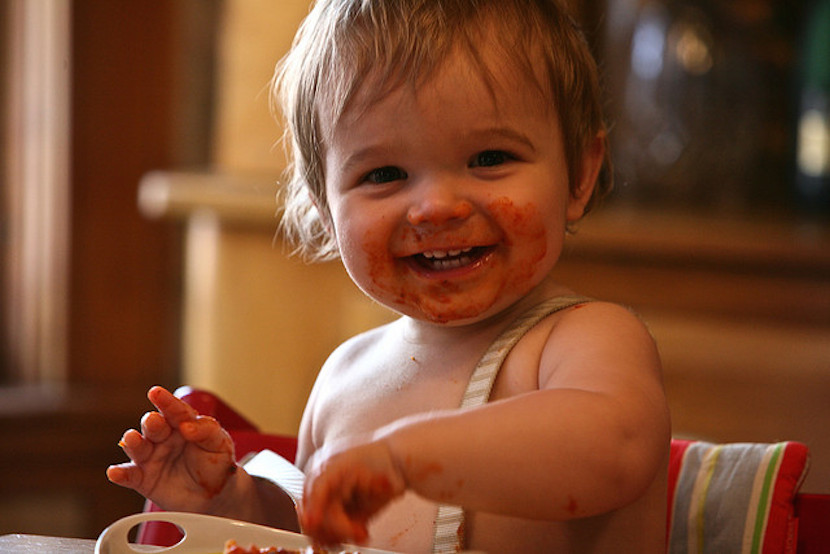
You will remember that a few months ago I told you about the introduction of complementary feeding from six months, and up to two years; Some ideas were clarified in the post, such as the ideal duration of breastfeeding, or the moment of introduction of different foods. We were talking about how there are children for whom puree does not suit them, and instead they want you to prepare the same as you do (which is logical: they are part of the family, and food unites). Today I'm going to go a little further: the 'baby led weaning' (BLW) is not new, but I find it very interesting, and probably the most natural way to introduce solids. It seems that in the United States it is quite widespread, and in Europe it is beginning to gain strength.
The basic principle is: the baby can self-regulate in terms of food, just as he demands milk when he is hungry, and in the amount he needs; In fact, this method does not contemplate the mashed ones either, because the little ones are allowed to directly grab a piece of cooked potato (for example) to put it in their mouth. Obviously, hard and difficult-to-chew foods (such as raw carrots) should be avoided; but If we think about it, there are many fruits or vegetables that can be offered raw, cut into sticks (peeled apple, cucumber, ...). Not counting on soft foods such as banana or cooked chicken, that fall apart when biting (a piece of bread), or that are thin and soft (cooked ham). Below I include two sites for more information, one is in Spanish and it's called a different motherhood, another is the Baby Led Weaning blog.
It is still too common to see adults who practically 'force' the baby to ingest and swallow, when and where they want (surprisingly, to fill their mouth with puree by force and stuff the pacifier so that they cannot spit, it is a practice that together with others are still being carried out). The BLW is almost the opposite: it allows the baby to participate in the rhythms of the family, sharing spaces, moments and food! They also go from taking the spaghetti with their hand, to looking for the spoon because they want to imitate the other diners. The biggest drawback in my opinion is that in this way the most immediate environment of the little one will end up very dirty, but in return you will have an autonomous baby, which you will not have to be aware of. But beware! Not having to be aware of it is not the same as being carefree and going to pick up clothes: it is very small so that you are alone at any time, except that you are asleep and that you cannot fall out of bed.
The method was disclosed by a nutritionist named Gill Rapley, and studied by Dr. Davis, who (together with her collaborators) verified in a very small sample of children, that babies achieved a good nutritional balance
In other words: the BLW is 'going from the tit to the plate' depending on the capacity and needs of the child. In my case, I never made the oldest child a puree or porridge, but gave it the same foods that his father and I ate, yes: crushed; At 7 months he already showed a lot of interest in complementary feeding, and he has not stopped eating everything until now (with the exception of a few weeks after the birth of his sister). Introducing solids in the small one, it was more according to this method (Although I did not know it then), he showed interest in our food before, he was able to take the pieces that interested him and put them in his mouth. However, he stopped at approximately 8 months to continue feeding exclusively on breast milk until he was almost a year old.
BLW: supplementary feeding on demand
The baby is the one who decides, but you are the one who cooks: he cannot open the refrigerator or the pantry, you can put a variety of nutrients on the table. How? An example: a little bread with tomato spread on top, some macaroni, a small bowl of stewed lentils (without the fat of the sausages), cooked apple, a piece of hard-boiled egg.
It has also been proven that children are able to avoid foods that have produced intolerances. In addition to the aforementioned autonomy, another advantage is the early contact with many flavors and textures, which favors its later acceptance. If they don't like any of them for another reason, they will also throw them away, but that's not a bad thing, I know dozens of adults who don't like a particular food.
Is the method safe?
Since you are present and have properly presented the food, it is unlikely that he suffers asphyxia by choking, we also have mechanisms to avoid this accident, which are coughing or retching originated to try to expel the foreign body. Also think that at 6 months (age at which it is recommended to start with complementary feeding) still can't pick up very small objectsThen they have perfected the chewing system, and they have more teeth.
We are talking about an age in which they stand upright even though they barely have mobility, so there should be no problems
In short, if you are interested in the method, you can learn more about it, sometimes parents feel very insecure with the introduction of solids, but everything is usually simpler than you think.
Picture - (the first) juhansonin on Flickr
